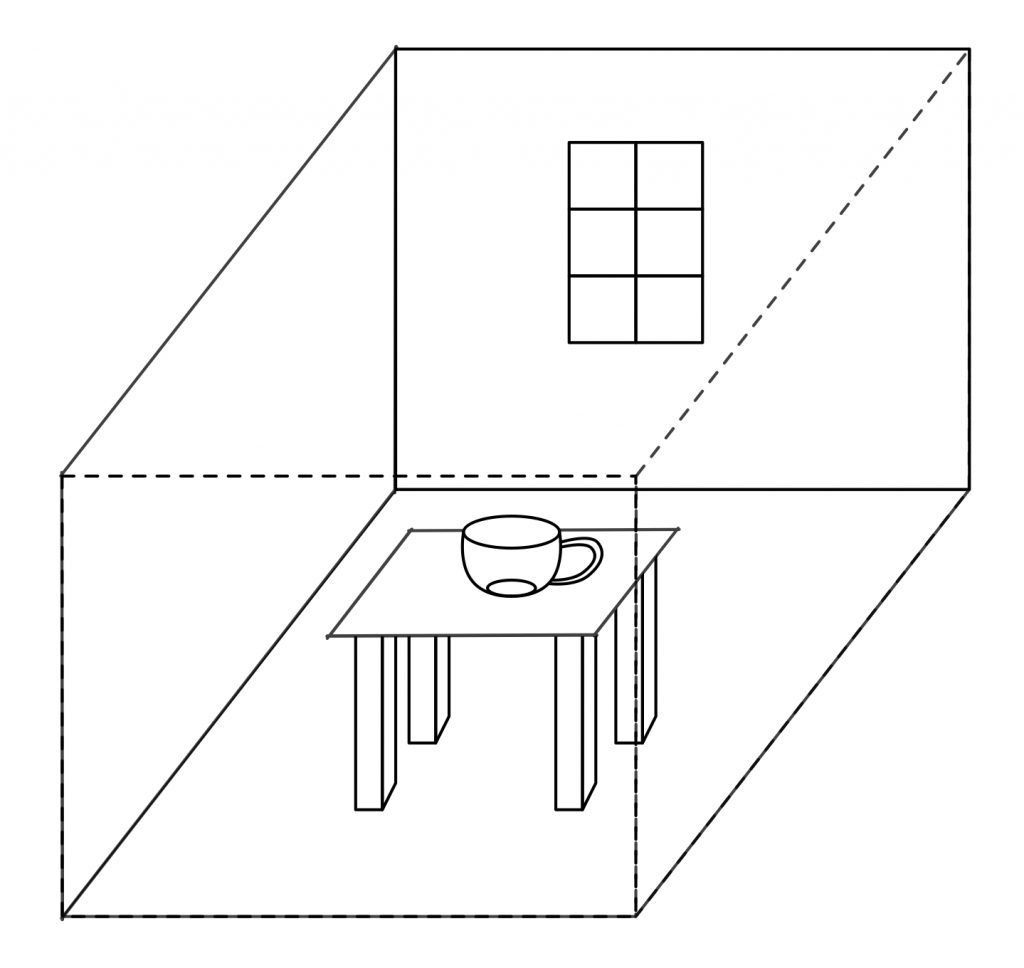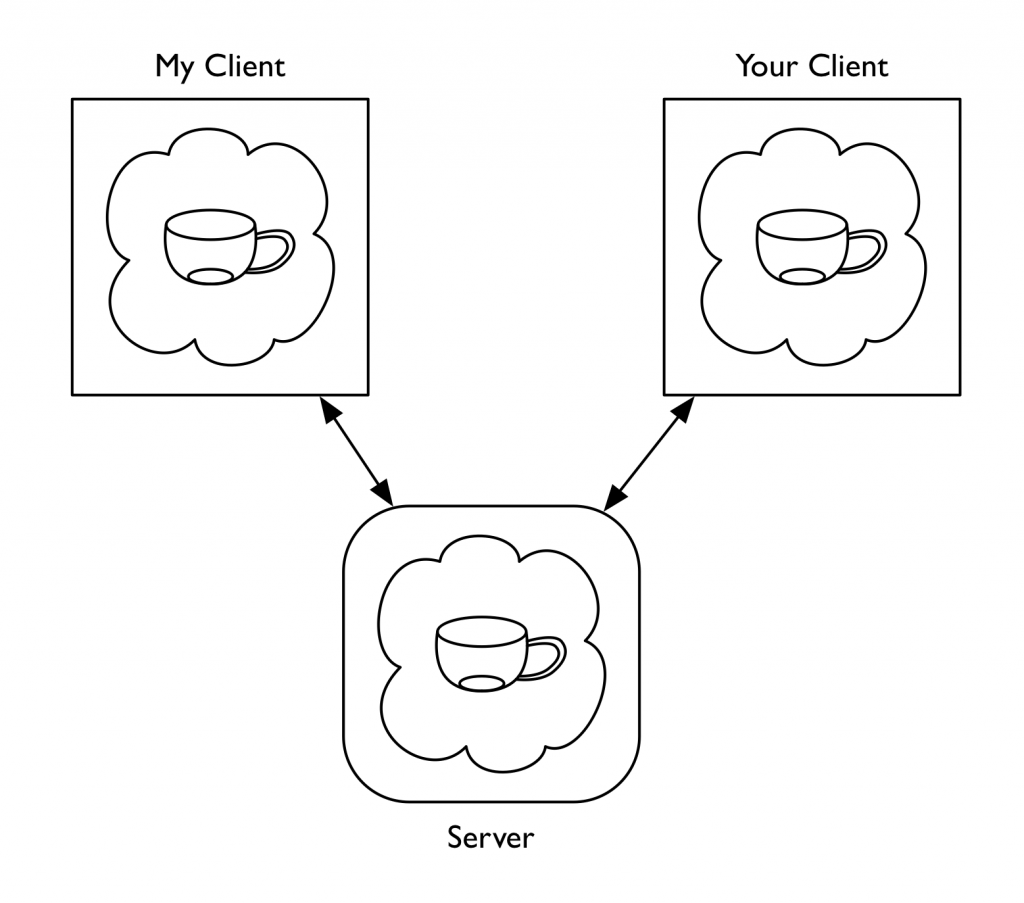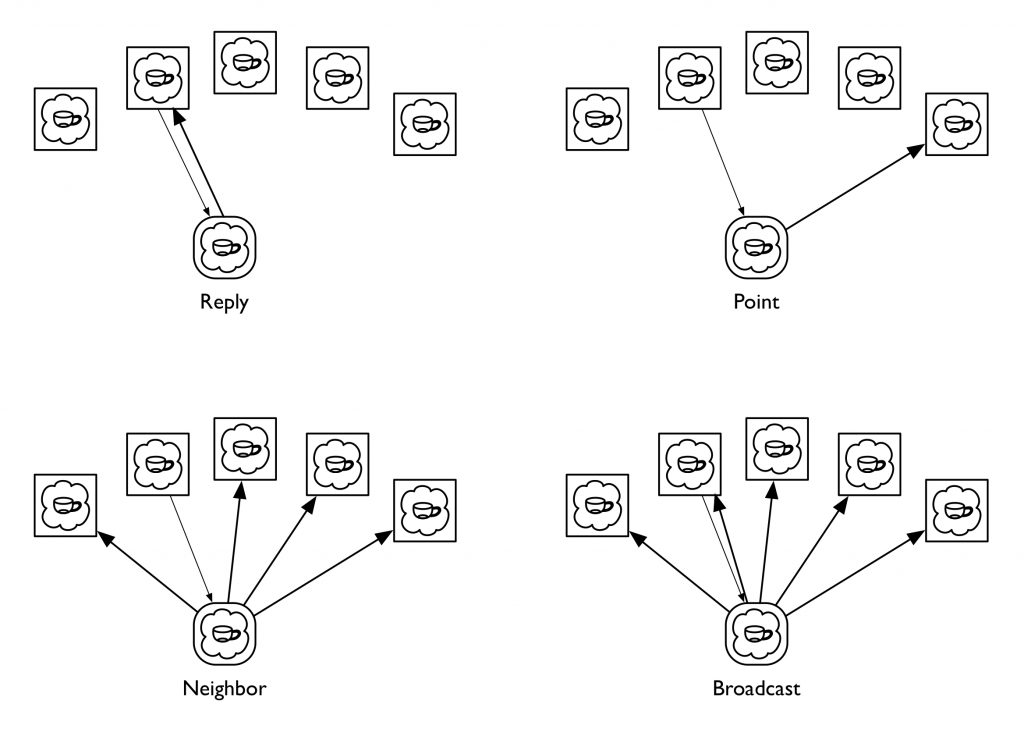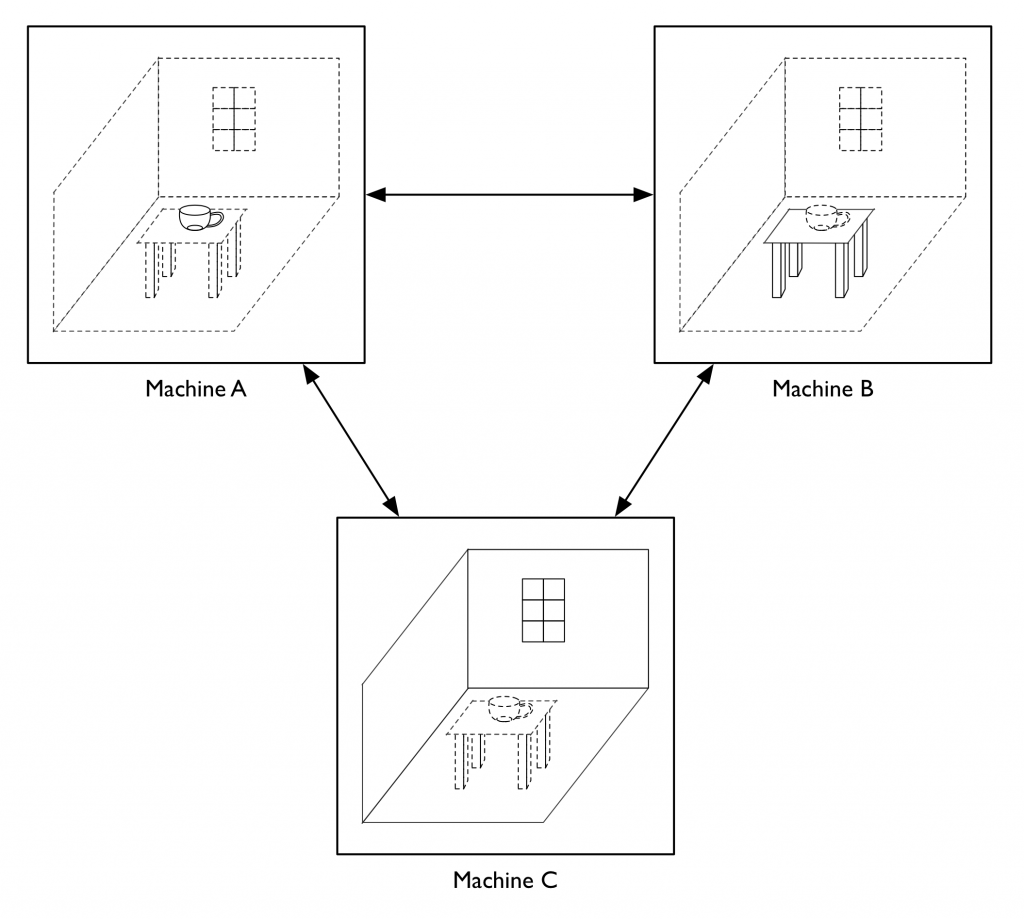Posts from August, 2019
August 28, 2019
The Unum Pattern
Warning: absurd technical geekery ahead — even compared to the kinds of things I normally talk about. Seriously. But things will be back to my normal level of still-pretty-geeky-but-basically-approachable soon enough.
[Historical note: This post has been a long time in the making — the roots of the fundamental idea being described here go back to the original Habitat system (although we didn’t realize it at the time). It describes a software design pattern for distributed objects — which we call the “unum” — that I and some of my co-conspirators at various companies have used to good effect in many different systems, but which is still obscure even among the people who do the kinds of things I do. In particular, I’ve described this stuff in conversation with lots of people over the years and a few of them have published descriptions of what they understood, but their writeups haven’t, to my sensibilities at least, quite captured the idea as I conceive of it. But I’ve only got myself to blame for this as I’ve been lax in actually writing down my own understanding of the idea, for all the usual reasons one has for not getting around to doing things one should be doing.]
Consider a distributed, multi-participant virtual world such as Habitat or one of its myriad descendants. This world is by its nature very object oriented, but not in quite the same way that we mean when we talk about, for example, object oriented programming. This is confusing because the implementation is, itself, very object oriented, in exactly the object oriented programming sense.
Imagine being in this virtual world somewhere, say, in a room in a building in downtown Populopolis. And there is a table in the room and sitting on the table is a teacup. Well, I said you were in the virtual world, but you’re not really in it, your avatar is in it, and you are just interacting with it through the mediation of some kind of client software running on your local computer (or perhaps these days on your phone), which is in turn communicating over a network connection to a server somewhere. So the question arises, where is the teacup, really? Certainly there is a representation of the teacup inside your local computer, but there is also a representation of the teacup inside the server. And if I am in the room with you (well, my avatar, but that’s not important right now), then there’s also a representation of the teacup inside my local computer. So is the teacup in your computer or in my computer or in the server? One reasonable answer is “all of the above”, but in my experience a lot of technical people will say that it’s “really” in the server, since they regard the server as the source of truth. But the correct answer is that the teacup is on a table in a room inside a building in Populopolis. The teacup occupies a different plane of existence from the software objects that are used to realize it. It has an objective identity of its own — if you and I each refer to it, we are talking about the same teacup — but this identity is entirely distinct from the identities of any of those software objects. And it has such an identity, because even though it’s on a different plane there still needs to be some kind of actual identifier that can be used in the communications protocols that the clients and the server use to talk to each other, so that they can refer to the teacup when they describe their manipulations of it and the things that happen to it.

You might distinguish between these two senses of “object” by using phrases with modifiers; for example, you might say “world object” versus “OOP object”, and in fact that is what we did for several years. However, this terminology made it easy to fall back on the shorthand of just talking about “objects” when it was clear from context which of these two meanings of “object” you meant. Of course, it often turned out that this context wasn’t actually clear to somebody in the conversation, with confusion and misunderstanding as the common result. So after a few false starts at crafting alternative jargon we settled on using the term “object” to always refer to an OOP object in an implementation and the term “unum”, from the latin meaning a single thing, to refer to a world object. This term has worked well for us, aside from endless debates about whether the plural is properly “una” or “unums” (my opinion is: take your pick; people will know what you mean either way).
Of course, we still have to explain the relationship between the unum and its implementation. The objects (using that word from now on according to our revised terminology) that realize the unum do live at particular memory addresses in particular computers. We think of the unum, in contrast, as having a distributed existence. We speak of the portion of the unum that resides in a particular machine as a “presence”. So to go back to the example I started with, the teacup unum has a presence on the server and presences on each of our client machines.

(As an aside, for the first few years of trying to explain to people how Habitat worked, I would sometimes find myself in confused discussions about “distributed objects”, by which the people with whom I was talking meant individual objects that were located at different places on the network, whereas I meant objects that were themselves distributed entities. I didn’t at first realize these conversations were at cross purposes because the model we had developed for Habitat seemed natural and obvious to me at the time — how else could it possibly work, after all? — and it took me a while to twig to the fact that other people conceived of things in a very different way. Another reason for introducing a new word.)
In the teacup example, we have a server presence and some number of client presences. The client presences are concerned with presenting the unum to their local users while the server presence is concerned with keeping track of that portion of the unum’s state which all the users share. Phrased this way, many people find the presence abstraction very natural, but it sometimes leads them to jump to conclusions about what is going on, resulting in still more confusion and conversation at cross purposes. People who implement distributed systems often build on top of frameworks that provide services like data replication, and so it is easy to fall into thinking of the server presence as the “real” version of the unum and the client presences as shadow copies that maintain a (perhaps slightly out of date) cached representation of the true state. Or thinking of the client presences as proxies of some kind. This is not exactly wrong, in the sense that you can certainly build systems that work this way, as many distributed applications — possibly including most commercially successful MMOs — actually do. However, it’s not the model I’m describing here.
One problem with data replication based schemes is that they don’t gracefully accommodate use cases that require some information be withheld from some participants (it’s not that you absolutely can’t do this, but it’s awkward and cuts against the grain). It’s not just that the server is authoritative about shared state, but also that the server is allowed to take into account private state that the clients don’t have, in order to determine how the shared state changes over time and in response to events.
A server presence and a client presence are not doing the same job. The fundamental underlying concept that presences embody is not some notion of master vs. replica, but division of labor. Each has distinct responsibilities in the joint work of being the unum. Each is authoritative about different aspects of the unum’s existence (and typically each will maintain private state of their own that they do not share with the other). In the case of the client-server model in our example, the client presence manages client-side concerns such as the state of the display. It worries about things like 3D rendering, animation sequencing, and presenting controls to the human user to manipulate the teacup with. The server keeps track of things like the physical model of the teacup within the virtual world. It worries about the interactions between the teacup and the table, for example. Each presence knows things that are none of the other presence’s business, either because that information is simply outside the scope of what the other presence does (such as the current animation frame or the force being applied to the table) or because it’s something the other presence is not supposed to know (such as the server knowing that this particular teacup has a hidden flaw that will cause it to break into several pieces if you pour hot water into it, revealing a secret message inscribed on the edges where it comes apart). The various different client presences may also have information they do not share with each other for reasons of function or privacy. For example, one client might do 3D rendering in a GUI window while another presents only a textual description with a command line interface. Perhaps the server has revealed the secret message hidden in the teacup to my client (and to none of the others) because I possess a magic amulet that lets me see such things.
We can loosely talk about “sending a message to an unum”, but the sending of messages is an OOP concept rather than a world model concept. Sending a message to an unum (which is not an object) is really sending a message to some presence of that unum (since a presence is an object). This means that to designate the target of such a message, the address needs two components: (1) the identity of the unum and (2) an indicator of which presences of that unum you want to talk to.
In the systems I’ve implemented (including Habitat, but also, perhaps more usefully for anyone who wants to play with these ideas, its Nth generation descendant, the Elko server framework), the objects on a machine within a given application all run inside a common execution environment — what we now call a “vat”. Cross-machine messages are transported over communications channels established between vats. In such a system, from a vat’s perspective the external presences of a given unum (that is, presences other than the local one) are thus in one-to-one correspondence with the message channels to the other vats that host those presences, so you can designate a presence by indicating the channel that leads to its vat. (For those presences you can talk to, anyway: the unum model does not require that a presence be able to directly communicate with all the other presences. For example, in the case of a Habitat or Elko-style system such as I am describing here, clients don’t talk to other clients, but only to the server.)
Here we encounter an asymmetry between client and server that is another frequent source of confusion. From the client’s perspective, there is only one open message channel — the one that talks to the server — and so the only other unum presence a client knows about is the server presence. In this situation, the identifier of the unum is sufficient to determine where a message should be sent, since there is only one possibility. Developers working on client-side code don’t have to distinguish between “send a message to the unum” and “send a message to the server presence of the unum”. Consequently, they can program to the conventional model of “send messages to objects on the other end of the connection” and everything works more or less the way they are used to. On the server side, however, things get more interesting. Here we encounter something that people accustomed to developing in the web world have usually never experienced: server code that is simultaneously in communication with multiple clients. This is where working with the unum pattern suddenly becomes very different, and also where it acquires much of its power and usefulness.
In the client-server unum model, the server can communicate with all of an unum’s client presences. Although a given message could be sent to any of them, or to all of them, or to any arbitrary subset of them, in practice we’ve found that a small number of messaging patterns suffice to capture everything we’ve wanted to do. More specifically, there are four patterns that in our experience are repeatedly useful, to the point where we’ve codified these in the messaging libraries we use to implement distributed applications. We call these four messaging patterns Reply, Neighbor, Broadcast, and Point, all framed in the context of processing some message that has been received by the server presence from one of the clients; among other things, this context identifies which client it was who sent it. A Reply message is directed back to the client presence that sent the message the server is processing. A Point message is directed to a specific client presence chosen by the server; this is similar to a Reply message except that the recipient is explicit rather than implied and could be any client regardless of context. A Broadcast message is sent to all the client presences, while a Neighbor message is directed to all the client presences except the sender of the message that the server is processing. The latter pattern is the one that people coming to the unum model for the first time tend to find weird; I’ll explain its use in a moment.

(Some people jump to the idea these four are all generalizations of the Point message, thinking it a good primitive to actually implement the other three, but in the systems we’ve built the messaging primitive is a lower level construct that handles fanout and routing for one or many recipients with a single, common mechanism so that we don’t have to multiply buffer the message if it has more than one target. In practice, we use Point messages rather rarely; in fact, using a Point message usually indicates that you’re doing something odd.)
The reason for there being multiple client presences in the first place is that the presences all share a common context in which the actions of one client can affect the others. This is in contrast to the classic web model in which each client is engaged in its own one-on-one dialog with the server, pretty much unrelated to any simultaneous dialogs the server might be having with other clients that just happen to be connected to it at the same time. However, the multiple-clients-in-a-shared-context model is a very good match for the kinds of online game and virtual world applications for which it was originated (it’s not that you can’t realize those kinds of applications using the web model, but, like the comment I made above about data replication, it’s cutting against the grain — it’s not a natural thing for web servers to do).
Actions initiated by a client typically take the form of a request message from that client to an unum’s server presence. The server’s handler for this message takes whatever actions are appropriate, then sends a Reply message back informing the requestor of the results of the action, along with a Neighbor message to the other client presences informing them of what just happened. The Reply and Neighbor messages generally have different payloads since the requestor typically already knows what’s going on and often merely needs a status result, whereas the other clients need to be informed of the action de novo. It is also common for the requestor to be a client that is in some privileged role with respect to the unum (perhaps the sending client is associated with the unum’s owner or holder, for example), and thus entitled to be given additional information in the Reply that is not shared with the other clients.
Actions initiated by the server, on the other hand, typically will be communicated to all the clients using the Broadcast pattern, since in this case none of the clients start out knowing what’s going on and thus all require the same information. The fact that the server can autonomously initiate actions is another difference between these kinds of systems and traditional web applications (server initiated actions are now supported by HTTP/2, albeit in a strange, inside out kind of way, but as far as I can tell they have yet to become part of the typical web application developer’s toolkit).
A direction that some people immediately want to go is to attempt to reduce the variety of messaging patterns by treating the coordination among presences as a data replication problem, which I’ve already said is not what we’re doing here. At the heart of this idea is a sense that you might make the development of presences simpler by reducing the differences between them — that rather than developing a client presence and a server presence as separate pieces of code, you could have a single implementation that will serve both ends of the connection (I can’t count the number of times I’ve seen game companies try to turn single player games into multiplayer games this way, and the results are usually pretty awful). Alternatively, one could implement one end and have the other be some kind of standardized one-side-fits-all thing that has no type-specific logic of its own. One issue with either of these approaches is how you handle the asymmetric information patterns inherent in the world model, but another is the division of labor itself. Systems built on the unum pattern tend to have message interfaces that are fundamentally about behavior rather than about data. That is, what is important about an unum is what it does. Habitat’s design was driven to a very large degree by the need for it to work effectively over 300 and 1200 baud connections. Behavioral protocols are vastly more effective at economizing on bandwidth than data based protocols. One way to think of this is as a form of highly optimized, knowledge-based data compression: if you already know what the possible actions are that can transform the state of something, a parameterized operation can often be represented much more compactly than can all state that is changed as a consequence of the action’s execution. In some sense, the unum pattern is about as anti-REST as you can be.
One idea that I think merits a lot more exploration is this: given the fundamental idea that an unum’s presences are factored according to a division of labor, are there other divisions of labor besides client-server that might be useful? I have a strong intuition that the answer is yes, but I don’t as yet have a lot of justification for that intuition. One obvious pattern to look into is a pure peer-to-peer model, where all presences are equally authoritative and the “true” state of reality is determined by some kind of distributed consensus mechanism. This is a notion we tinkered with a little bit at Electric Communities, but not to any particular conclusion. For the moment, this remains a research question.
One of the things we did do at Electric Communities was build a system where the client-server distinction was on a per-unum basis, rather than “client” and “server” being roles assigned to the two ends of a network connection. To return to our example of a teacup on a table in a room, you might have the server presence of the teacup be on machine A, with machines B and C acting as clients, while machine B is the server for the table and machine C is the server for the room. Obviously, this can only happen if there is N-way connectivity among all the participants, in contrast to the traditional two-way connectivity we use in the web, though whether this is realized via pairwise connections to a central routing hub or as a true crossbar is left as an implementation detail. This kind of per-unum relationship typing was one of the keys to our strategy for making our framework support a world that was both decentralized and openly extensible. (Continuing with the question raised in the last paragraph, an obvious generalization would be to allow the division of labor scheme itself vary from one unum to another. This suggests that a system whose unums are all initially structured according to the client-server model could still potentially act as a test bed for different schemes for dividing up functionality over the network.)

Having the locus of authoritativeness with respect to shared state vary from one unum to another opens up lots of interesting questions about the semantics of inter-unum relationships. In particular, there is a fairly broad set of issues that at Electric Communities we came to refer to as “the containership problem”, concerning how to model one unum containing another when the una are hosted on separate machines, and especially how to deal with changes in the containership relation. For example, let’s say we want to take our teacup that’s sitting on the table and put it into a box that’s on the table next to it. Is that an operation on the teacup or on the box? If we have the teacup be authoritative about what its container is, it could conceivably teleport itself from one place to another, or insert itself into places it doesn’t belong. On the other hand, if we have the box be authoritative about what it contains, then it could claim to contain (or not contain) anything it decides it wants. Obviously there needs to be some kind of handshake between the two (or between the three, if what we’re doing is moving an unum from one container to another, since both containers may have an interest — or among the two or three and whatever entity is initiating the change of containership, since that entity too may have something to say about things), but what form that handshake takes leads to a research program probably worthy of being somebody’s PhD thesis project.
Setting aside some of these more exotic possibilities for a moment, we have found the unum pattern to be a powerful and effective tool for implementing virtual worlds and lots of other applications that have some kind of world-like flavor, which, once you start looking at things through a world builder’s lens, is a fairly diverse lot, including smart contracts, multi-party negotiations, auctions, chat systems, presentation and conferencing systems, and, of course, all kinds of multiplayer games. And if you dig into some of the weirder things that we never had the chance to get into in too much depth, I think you have a rich universe of possibilities that is still ripe for exploration.